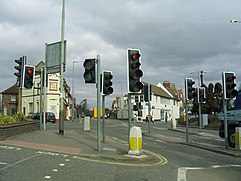Silverhill, Hastings
| Silverhill | |
|---|---|
 Silverhill Junction prior to the construction of the 'Asda' store. The buildings on the left were demolished in 2010 as part of that construction work. |
|
| Silverhill shown within East Sussex | |
| Population | 4,806 (2011.ward) |
| District | |
| Shire county | |
| Region | |
| Country | England |
| Sovereign state | United Kingdom |
| Post town | ST. LEONARDS-ON-SEA |
| Postcode district | TN37/TN38 |
| Dialling code | 01424 |
| Police | Sussex |
| Fire | East Sussex |
| Ambulance | South East Coast |
| EU Parliament | South East England |
Silverhill is a suburb and Local Government Ward of Hastings, East Sussex. It has a central location within the town, where the A21 meets the B2159 road.
The origin of the name Silverhill is unknown: the first documentary record of the name is on Yeakell and Gardner's map of 1783, where it appears as "Salver Hill".
In the early 18th century this was the location of High Ridge Farm, but by 1815 its name was known as Silver Hill Farm to avoid confusion with farms of a similar name on the ridge near Ore. The tenant farmer was John Standen, and the farm remained with his family until 1842, when it was bought by Francis Smith.
The Silverhill pottery opened in 1838 and provided an important source of employment for local people. It consisted of a large open shed with a tiled roof and a round kiln where roof tiles and chimney pots were made.
From the early 1840s the Pottery was owned by Fred Tree, and among his workers was an artistic potter named John Pelling who was promoted to foreman in 1846. John bought the pottery works five years later and married Fred's daughter, Polly. He became well known for creating a unique style of rustic pottery with a wood-bark design, and according to a local story this was inspired by Polly's maiden name.
The Tivoli Hotel (not to be confused with the Tivoli Tavern situated further up Battle Road and demolished in 2013) stood at the junction of Battle Road (B2159) and Sedlescombe Road North between 1836 and 1860 and, this high-class establishment was so well known that, its local area was known as "Tivoli". The Tivoli Hotel was possibly near where Barclays Silverhill branch now is.
After founding his new town of St Leonards-on-Sea, James Burton gained permission by an Act of Parliament of 1837 to build a turnpike road northwards from Maze Hill to avoid the congestion in Hastings.
However, when this was authorized, the Hastings Council also obtained the necessary Turnpike Act to build a new road towards London. This road started at Hastings town centre and continued through Bohemia into Battle Road, crossing Burton's road at the Tivoli Hotel. Battle Road is now the B2159, and the road that goes through Battle is the A2100.
...
Wikipedia

